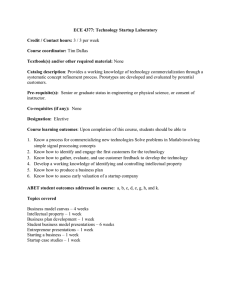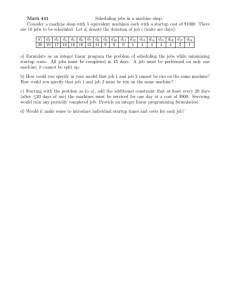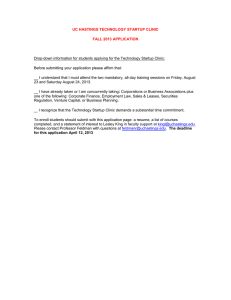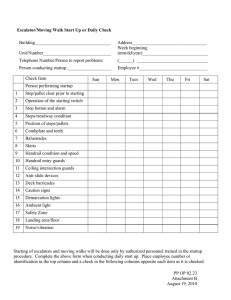The Top 20 Reasons Startups Fail
advertisement
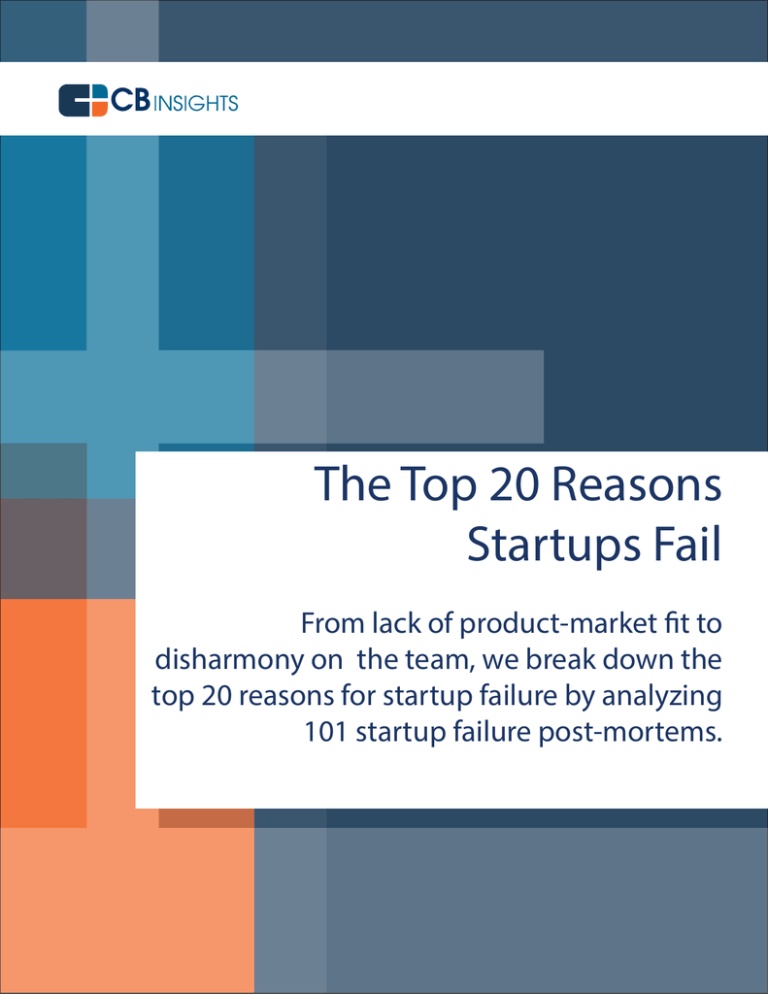
The Top 20 Reasons Startups Fail From lack of product-market fit to disharmony on the team, we break down the top 20 reasons for startup failure by analyzing 101 startup failure post-mortems. After we compiled our list of startup failure post-mortems, one of the most frequent requests we received was if we could distill the reasons for failure down from all these posts. Startups, investors, economic development folks, academics and corporations all wanted some insight into the question: “Are there a few primary drivers of startup failure?” So we gave those post-mortems the CB Insights’ data treatment to see if we could answer this question. And so after reading through every single of the 101 postmortems, we’ve learned two things. One – there is rarely one reason for a single startup’s failure. And two – across all these failures, the reasons are very diverse. And so after sifting through these post-mortems, we identified the 20 most frequently cited reasons for failure. Since many startups offered multiple reasons for their failure, you’ll see that chart highlighting the top 20 reasons doesn’t add upto 100% (it far exceeds it). Following the chart is an explanation of each reason and relevant examples from the postmortems. There is certainly no survivorship bias here. But many very relevant lessons for anyone involved in the entrepreneurial ecosystem. It’s worth noting that this type of data-driven analysis would not be possible without a number of founders being courageous enough to share the stories of their startup’s demise with the world. So a big thank you to them. cbinsights.com 2 cbinsights.com 3 #20 – Failure to pivot when necessary Not pivoting away or quickly enough from a bad product, a bad hire or a bad decision quickly enough was cited as a reason for failure in 7% of the post mortems. Dwelling or being married to a bad idea can sap resources and money as well as leave employees frustrated by a lack of progress. As Keith Nowak writes in Imercive’s post-mortem: “We were caught mid-pivot – half way between a strategy we knew wouldn’t work and one which we believed could be successful but was not able to be aggressively pursued. This was a very difficult place to be both professionally and personally. We were extremely frustrated at not being able to properly go after our new strategy and every day that passed without meaningful progress was one step closer to the failure of my first company. Even though we put everything we had into getting through this phase we were never able to make it through the pivot.” #19 – Burn Out Work life balance is not something that startup founders often get and so the risk of burning out is high. Burn out was given as a reason for failure 8% of the time The ability to cut your losses where necessary and re-direct your efforts when you see a dead end was deemed important to succeeding and avoiding burnout as was having a solid, diverse and driven team so that responsibilities can be shared. The post-mortem of Blurtt gets into the impact of burnout on a startup’s momentum – writing: #18 – Do not use your connections or network We often hear about startup entrepreneurs lamenting their lack of network or investor connections so we were surprised to see that one of the reasons for failure was entrepreneurs who said they did not properly utilize their own network. As Kiko wrote, “Get your investors involved. Your investors are there to help you. Get them involved from the start, and don’t be afraid to ask for help. I think we made the mistake early on of trying to do (and know) everything ourselves, perhaps out of insecurity over being so new to the business world. This is a mistake.” cbinsights.com 4 #17 – Legal Challenges Sometimes a startup can evolve from a simple idea to a world of legal complexities that can prove to be a core cause of shutting a startup down. As Decide.com wrote in their post-mortem, “We received a notice from them informing us we weren’t compliant and unless we removed it they’d suspend our affiliate account. We weren’t making a lot of money but that account probably represented more than 80% our revenue.” A couple music startup post-mortems also associated the high costs of dealing with record labels and legal headaches as a reason for startup failure. High-profile startup Turntable.fm wrote, “Ultimately, I didn’t heed the lessons of so many failed music startups. It’s an incredibly expensive venture to pursue and a hard industry to work with. We spent more than a quarter of our cash on lawyers, royalties and services related to supporting music. It’s restrictive. We had to shut down our growth because we couldn’t launch internationally.” #16 – No Financing or Interested Investors Tying to the more common reason of running out of cash, a number of startup founders explicitly cited a lack of investor interest either at the seed follow-on stage (the Series A Crunch) or at all. #15 – Location, Location, Location Location was an issue in a couple different ways. The first was that there has to be congruence between your startup’s concept and location. As Meetro wrote, “We launched our product and got all of our friends in Chicago on it. We then had the largest papers in the area do nice detailed write-ups on us. Things were going great…The problem we would soon find out was that having hundreds of active users in Chicago didn’t mean that you would have even two active users in Milwaukee, less than a hundred miles away, not to mention any in New York or San Francisco. The software and concept simply didn’t scale beyond its physical borders.” cbinsights.com 5 Location also played a role in failure for remote teams. The key being that if your team is working remotely, make sure you find effective communication methods; else lack of teamwork and planning could lead to failure. As Devver wrote, “The most significant drawback to a remote team is the administrative hassle. It’s a pain to manage payroll, unemployment, insurance, etc in one state… for a small team, it was a major annoyance and distraction.” #14 – Lack Passion and Domain Expertise There are many good ideas out there in the world, but 9% of startup post-mortem founders found that a lack of passion for a domain and a lack of knowledge of a domain were key reasons for failure no matter how good an idea is. In their post- mortem, NewsTilt candidly spoke about their lack of interest in the domain they selected writing: “I think it’s fair to say we didn’t really care about journalism. We started by building a commenting product which came from my desire for the perfect commenting system for my blog. This turned into designing the best damn commenting system ever, which led to figuring out an ideal customer: newspapers. While there, we figured they were never going to buy, and we figured out a product that people were dying to use if it existed. But we didn’t really care about journalism, and weren’t even avid news readers. If the first thing we did every day was go to news.bbc.co.uk, we should have been making this product. But even when we had NewsTilt, it wasn’t my go-to place to be entertained, that was still Hacker News and Reddit. And how could we build a product that we were only interested in from a business perspective.” #13 Pivot Gone Bad Pivots like Burbn to Instagram or ThePoint to Groupon can go extraordinarily well. Or they can be the start of a path down the wrong road. As Flowtab’s post-mortem explains, “Pivoting for pivoting’s sake is worthless. It should be a calculated affair, where changes to the business model are made, hypotheses are tested, and results are measured. Otherwise, you can’t learn anything.” cbinsights.com 6 #12 – Disharmony with Investors/Co-founders Discord with a cofounder was a fatal issue for startup post-mortem companies. But acrimony isn’t limited to the founding team, and when things go bad with an investor, it can get ugly pretty quickly as evidenced in the case of ArsDigital. Phillip Greenspun writes: “For roughly one year Peter Bloom (General Atlantic), Chip Hazard (Greylock), and Allen Shaheen (CEO) exercised absolute power over ArsDigita Corporation. During this year they 1. spent $20 million to get back to the same revenue that I had when I was CEO 2. declined Microsoft’s offer (summer 2000) to be the first enterprise software company with a .NET product (a Microsoft employee came back from a followup meeting with Allen and said “He reminds me of a lot of CEOs of companies that we’ve worked with… that have gone bankrupt.”) 3. deprecated the old feature-complete product (ACS 3.4) before finishing the new product (ACS 4.x); note that this is a well-known way to kill a company among people with software products experience; Informix self-destructed because people couldn’t figure out whether to run the old proven version 7 or the new fancy version 9 so they converted to Oracle instead) 4. created a vastly higher cost structure; I had 80 people mostly on base salaries under $100,000 and was bringing in revenue at the rate of $20 million annually. The ArsDigita of Greylock, General Atlantic, and Allen had nearly 200 with lots of new executive positions at $200,000 or over, programmers at base salaries of $125,000, etc. Contributing to the high cost structure was the new culture of working 9-5 Monday through Friday. Allen, Greylock, and General Atlantic wouldn’t be in the building on weekends and neither would the employees bother to come in. 5. surrendered market leadership and thought leadership” cbinsights.com 7 #11 – Lose Focus Getting sidetracked by distracting projects, personal issues, and/or general loss of focus was mentioned 13% as a contributor to failure. As MyFavorites wrote on the end of their startup experience, “Ultimately when we came back from SXSW, we all started losing interest, the team was all wondering where this was eventually going, and I was wondering if I even wanted to run a startup, have investors, have the responsibility of employees and answering to a board of investors.” #10 – Release product at the wrong time If you release your product too early, users may write it off as not good enough and getting them back may be difficult if their first impression of you was negative. And if you release your product too late, you may have missed your window of opportunity in the market. As a Calxeda employee said, “In [Calxeda’s] case, we moved faster than our customers could move. We moved with tech that wasn’t really ready for them – ie, with 32-bit when they wanted 64-bit. We moved when the operating-system environment was still being fleshed out - [Ubuntu Linux maker] Canonical is all right, but where is Red Hat? We were too early.” #9 – Being inflexible and not actively seeking or using customer feedback Ignoring users is a tried and true way to fail. Tunnel vision and not gathering user feedback are fatal flaws for most startups. For instance, eCrowds, a web content management system company, said that “We spent way too much time building it for ourselves and not getting feedback from prospects — it’s easy to get tunnel vision. I’d recommend not going more than two or three months from the initial start to getting in the hands of prospects that are truly objective.” Similarly, VoterTide wrote, “We didn’t spend enough time talking with customers and were rolling out features that I thought were great, but we didn’t gather enough input from clients. We didn’t realize it until it was too late. It’s easy to get tricked into thinking your thing is cool. You have to pay attention to your customers and adapt to their needs.” cbinsights.com 8 #8 – Poor Marketing Knowing your target audience and knowing how to get their attention and convert them to leads and ultimately customers is one of the most important skills of a successful business. The inability to market was a function of founders who liked to code or build product but who didn’t relish the idea of promoting the product and came up in 14% of the startup postmortems. As Overto wrote, “Thin line between life and death of internet service is a number of users. For the initial period of time the numbers were growing systematically. Then we hit the ceiling of what we could achieve effortlessly. It was a time to do some marketing. Unfortunately no one of us was skilled in that area. Even worse, no one had enough time to fill the gap. That would be another stopper if we dealt with the problems mentioned above.” #7 – I got this product. Now I just need a business model. Failed founders seem to agree that a business model is important – staying wedded to a single channel or failing to find ways to make money at scale left investors hesitant and founders unable to capitalize on any traction gained. As Tutorspree wrote, “Although we achieved a lot with Tutorspree, we failed to create a scalable business….Tutorspree didn’t scale because we were single channel dependent and that channel shifted on us radically and suddenly. SEO was baked into our model from the start, and it became increasingly important to the business as we grew and evolved. In our early days, and during Y Combinator, we didn’t have money to spend on acquisition. SEO was free so we focused on it and got good at it.” #6 – A “User Un-Friendly” Product Bad things happen when you ignore a user’s wants and needs whether done consciously or accidentally. Here’s what GameLayers wrote on their product UI, “Ultimately I believe PMOG lacked too much core game compulsion to drive enthusiastic mass adoption. The concept of “leave a trail of playful web annotations” was too abstruse for the bulk of folks to take up. Looking back I believe we needed to clear the decks, swallow our pride, and make something that was easier to have fun with, within the first few moments of interaction.” cbinsights.com 9 #5 – Pricing/Cost Issues Pricing is a dark art when it comes to startup success and startup post-mortems highlight this difficulty in pricing a product was not too high or too low to make money in context of the particular costs of a company. Delight IO saw this struggle in multiple ways, writing, “Our most expensive monthly plan was US$300. Customers who churned never complained about the price. We just didn’t deliver up to their expectation. We originally price by the number of recording credits. Since our customers had no control on the length of the recordings, most of them were very cautious on using up the credits. Plans based on the accumulated duration of recordings make much more sense for us and the number of subscription showed.” #4 – Get outcompeted Despite the platitudes that startups shouldn’t pay attention to the competition, the reality is that once an idea gets hot or gets market validation, there may be many entrants in a space. And while obsessing over the competition is not healthy, ignoring them was also a recipe for failure in 19% of the startup failures. Mark Hedland of Wesabe talked about this in his post-mortem stating: “Between the worse data aggregation method and the much higher amount of work Wesabe made you do, it was far easier to have a good experience on Mint, and that good experience came far more quickly. Everything I’ve mentioned — not being dependent on a single source provider, preserving users’ privacy, helping users actually make positive change in their financial lives — all of those things are great, rational reasons to pursue what we pursued. But none of them matter if the product is harder to use.” #3 – Not the right team A diverse team with different skill sets was often cited as being critical to the success of a starting a company. Failure post-mortems often lamented that “I wish we had a CTO from the start, or wished that the startup had “a founder that loved the business aspect cbinsights.com 10 of things”. Standout Jobs wrote in their post-mortem, “…The founding team couldn’t build an MVP on its own. That was a mistake. If the founding team can’t put out product on its own (or with a small amount of external help from freelancers) they shouldn’t be founding a startup. We could have brought on additional co-founders, who would have been compensated primarily with equity versus cash, but we didn’t.” In some cases, the founding team wished they had more checks and balances. As Nouncers founder wrote, “This brings me back to the underlying problem I didn’t have a partner to balance me out and provide sanity checks for business and technology decisions made.” #2 – Ran out of cash Money and time are finite and need to be allocated judiciously. The question of how should you spend your money was a frequent conundrum and reason for failure cited by failed startups (29%). As the team at Flud exemplified, running out of cash was often tied to other reasons for startup failure into product-market fit and failed pivots, “In fact what eventually killed Flud was that the company wasn’t able to raise this additional funding. Despite multiple approaches and incarnations in pursuit of the ever elusive productmarket fit (and monetization), Flud eventually ran out of money — and a runway.” #1 – Building a solution looking for a problem, i.e., not targeting a “market need” Tackling problems that are interesting to solve rather than those that serve a market need was cited as the number one reason for failure in a notable 42% of cases. As Patient Communicator wrote, “I realized, essentially, that we had no customers because no one was really interested in the model we were pitching. Doctors want more patients, not an efficient office.” Treehouse Logic applied the concept more broadly in their post-mortem, writing, “Startups fail when they are not solving a market problem. We were not solving a large enough problem that we could universally serve with a scalable solution. We had great technology, great data on shopping behavior, great reputation as a though leader, great expertise, great advisors, etc, but what we didn’t have was technology or business model that solved a pain point in a scalable way. cbinsights.com 11 Want access to the most comprehensive database of venture capital financing and exit data? (Here’s how to get it) SIGN UP FOR FREE cbinsights.com 12

